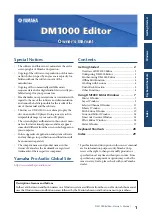
CHAPTER 21. LIVE AUDIO EFFECT REFERENCE
305
21.15
Gate
The Gate Effect.
The Gate effect passes only signals whose level exceeds a user-speci ed threshold. A gate
can eliminate low-level noise that occurs between sounds (e.g., hiss or hum), or shape a
sound by turning up the threshold to where it cuts off reverb or delay tails or truncates an
instrument's natural decay.
The Threshold slider sets the gate's sensitivity. If the gate is open and passing signal (i.e.,
the signal exceeds the gate threshold), the green LED lights.
The Attenuation slider, located beneath the Threshold fader, can attenuate signals below
the threshold rather than just cutting them off. If set to -inf dB, a closed gate will mute the
input signal. A setting of 0.00 dB means that even if the gate is closed, there is no effect
on the signal. Settings in between these two extremes attenuate the input to a greater or
lesser degree when the gate is closed.
With the Flip button enabled, the gate works in reverse; the signal will only pass if its level
is
below
the threshold.
The Attack time determines how long it takes for the gate to switch from closed to open
when a signal goes from below to above the threshold. Very short attack times can produce
sharp clicking sounds, while long times soften the sound's attack.
When the signal goes from above to below the threshold, the Hold time kicks in. (Note
to tech heads: the gate has hysteresis, so the release occurs about 3 dB lower than the
threshold.) After the hold time expires, the gate closes over a period of time set by the
Release parameter.
















































